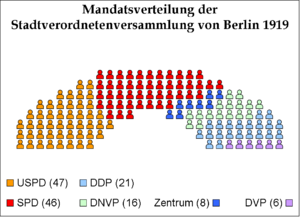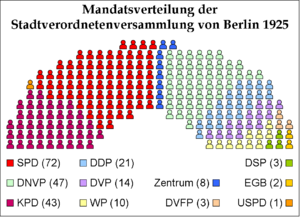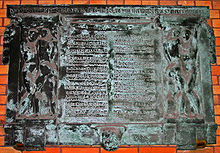Berlin city council
The Berlin City Council (StVV) was the local parliament of the city of Berlin that existed from 1809 . Her successor in the western part of the city has been the Berlin House of Representatives as the state parliament of the city-state of (West) Berlin on the one hand and the district council meetings on the district level on the other. In East Berlin, the city council continued from 1957 to 1990.
Prussia
The Prussian town order of 1808 regulated the introduction of a representative body at the municipal level for the first time. However, the elections for the newly established Berlin City Council were not very democratic by today's standards. The census suffrage tied eligibility to income and property. The prerequisite for the right to vote was a minimum income (150–200 thalers), the so-called census. The stand for election was for 2 / 3 tied the seats to land. Only men were eligible to vote. The women's suffrage was introduced in the Weimar Republic.
The first meeting of the Berlin StVV took place on July 6, 1809 in the Nikolaikirche . On January 6, 1870, the Berlin StVV met for the first time in the new Red Town Hall , the symbol of the bourgeois city administration and its emerging bourgeois communal self-confidence - also towards the Prussian state authorities.
The heads of the Berlin city council from 1809 to 1918
- Leopold von Gerlach (* 1757; † 1813): 1809
- Paul Humbert: 1809-1818
- Philipp Krutisch: 1819-1820
- Christian Behrendt: 1821–1822, 1826
- Ernst von Koenen: 1823–1824
- Wilhelm Junge: 1825
- Johann Ludwig Uhde: 1827
- Johann Friedrich Dasselmann: 1828–1844
- Friedrich Fournier: 1845-1848
- Gustav Seidel: 1848–1850
- August Otto Fähndrich: 1850–1857
- Karl Esse: 1858–1860
- Karl Lüttig: 1860–1862
- Heinrich Kochhann (* 1805; † 1890; 39th honorary citizen of the city [1875] ): 1863–1874
- Wolfgang Straßmann : 1875–1885
- Walter Büchtemann : 1885–1886
- Albert Stryck: 1886-1893
- Paul Langerhans senior (* 1820; † 1909; 45th honorary citizen of the city [1900] ): 1893–1908
- Paul Michelet (* 1835; † 1926; 51st honorary citizen of the city [1914] ): 1908–1918
In the Red City Hall, memorial plaques still commemorate the first meeting of the StVV in the new building (in the inner courtyard) and - barely legible - all the city councilors from 1809 to 1908 (on the left in the passage area from the eastern side entrance, Jüdenstrasse 1, to the inner courtyard).
Weimar Republic
Free elections to the StVV were held for the first time in the Weimar Republic. In 1920, Berlin was significantly expanded to include Greater Berlin with the “Law on the Formation of a New City Council in Berlin” .
The heads of the Berlin city council from 1918 to 1933
- Paul Michelet : until 1919
- Hermann Weyl ( USPD ) and Hugo Heimann ( SPD ): 1919–1920
- Wilhelm Caspari ( DVP ): 1921-1924
- Johannes Hass (SPD): 1924–1933
- Karl Spiewok ( NSV ): 1933
Elections to the Berlin city council
This list contains the results of the elections for the Berlin StVV in the Weimar Republic .
Election to the city council of Berlin in 1919

| Political party | proportion of | Seats | graphic |
|---|---|---|---|
| USPD | 33.0% | 47 |

|
| SPD | 31.8% | 46 | |
| DDP | 14.5% | 21st | |
| DNVP | 10.5% | 16 | |
| center | 5.7% | 8th | |
| DVP | 4.6% | 6th |
Election to the city council of Berlin in 1920
| Political party | proportion of | Seats | graphic |
|---|---|---|---|
| USPD | 38.5% | 48 |

|
| DVP | 17.8% | 40 | |
| SPD | 17.2% | 17th | |
| DNVP | 11.4% | 9 | |
| DDP | 7.1% | 4th |
Election to the city council of Greater Berlin in 1921
| Political party | proportion of | Seats | graphic |
|---|---|---|---|
| SPD | 20.5% | 46 |

|
| USPD | 19.2% | 43 | |
| DNVP | 18.6% | 41 | |
| DVP | 15.5% | 35 | |
| KPD | 9.5% | 21st | |
| DDP | 7.4% | 17th | |
| WP | 5.1% | 12 | |
| center | 3.7% | 8th | |
| DSP | 0.7% | 1 |
Election to the city council of Greater Berlin in 1925
| Political party | proportion of | Seats | graphic |
|---|---|---|---|
| SPD | 32.6% | 73 |

|
| DNVP | 20.8% | 47 | |
| KPD | 18.8% | 43 | |
| DDP | 9.3% | 21st | |
| DVP | 6.0% | 14th | |
| WP | 4.0% | 10 | |
| center | 3.4% | 8th | |
| DVFP | 1.5% | 3 | |
| DSP | 1.4% | 3 | |
| EGB | 0.9% | 2 | |
| USPD | 0.8% | 1 |
Election to the city council of Greater Berlin in 1929
| Political party | proportion of | Seats | graphic |
|---|---|---|---|
| SPD | 28.4% | 64 |

|
| KPD | 24.6% | 56 | |
| DNVP | 17.6% | 40 | |
| DVP | 6.7% | 16 | |
| DDP | 6.0% | 14th | |
| NSDAP | 5.8% | 13 | |
| WP | 4.4% | 10 | |
| center | 3.6% | 8th | |
| CVD | 1.3% | 3 | |
| DVFB | 0.3% | 1 |
Election to the city council of Greater Berlin in 1933
| Political party | proportion of | Seats | graphic |
|---|---|---|---|
| NSDAP | 38.3% | 86 |

|
| SPD | 22.0% | 50 | |
| KPD | 19.5% | 44 | |
| DNVP | 12.1% | 27 | |
| center | 2.7% | 11 | |
| DStP | 2.1% | 4th | |
| DVP | 0.7% | 2 | |
| CSVD | 0.6% | 1 |
time of the nationalsocialism
The last meeting of the Berlin StVV took place on June 27, 1933. On March 15 elected Berlin Council was dissolved and the city council Lippert ( NSDAP ) by the Prussian Interior Minister Goering appointed (NSDAP) State Commissioner.
post war period

On October 20, 1946, the first and last election for an all-Berlin city council took place between 1933 and the reunification of Berlin in 1990. The election took place in Greater Berlin, i. H. in all four sectors . In this election, unlike in the Soviet occupation zone (SBZ), the Socialist Unity Party of Germany (SED ), which was created under Soviet pressure, also had to run against the Berlin SPD , which had successfully opposed the forced unification of the SPD and KPD to form the SED . The election ended with a victory for the SPD (48.7%; 63 of the 130 seats) and a fiasco for the SED (19.8%; 26 seats). According to Hermann Weber , the elections showed that in competition with the SPD and in free elections, the SED “had no chance of achieving the desired hegemony”.
| Political party | SPD | CDU | SED | LDP |
|---|---|---|---|---|
| proportion of | 48.7% | 22.2% | 19.8% | 9.3% |
Otto Suhr (SPD) was elected head of the city council on November 26, 1946.
In the period that followed, the Soviet occupying power (SMAD) and the SED increasingly hindered the political work of the democratic parties in East Berlin . In the course of the year, the formation of the Democratic Bloc led to a split between the CDU and the LDP . On March 11, 1948, the StVV decided to protest against the obstruction of the work of the democratic parties in the eastern sector of the city.
With the end of the joint work of the Allied Command by the Soviet Union on June 16, 1948 as a result of the implementation of the currency reform and the subsequent blockade of the western sectors , the work of the Berlin StVV became increasingly difficult. On June 23, unhindered by the police force present, rioters mobilized by the SED entered the New Town Hall for the first time and prevented the StVV meeting. This was repeated several times until on September 6, 1948 the StVV moved to the British sector in Charlottenburg to meet in the student house of the Technical University . The SED city council boycotted the move.
On November 30, 1948, the unified local government in Berlin ended. The 2nd Deputy City Councilor Ottomar Geschke (SED) convened an "extraordinary city council meeting" in the Admiralspalast in the Soviet sector. The 26 city councilors of the SED, 213 representatives of the democratic bloc, including a few city councilors from the CDU and LDP from the Eastern sector, came together with 1151 "delegates" from East Berlin companies appointed on the same day and 224 members of "mass organizations". They declared the magistrate deposed and formed a "provisional democratic magistrate" under the control of the SED with Friedrich Ebert junior (SED) as mayor, whom the Soviet occupying power immediately recognized as the only legitimate Berlin magistrate. A vote that the GDR also joined when it was founded in 1949 .
The election to the city council of Greater Berlin, which was laid down by the Allies on August 13, 1946 in the preliminary constitution of Greater Berlin , could only take place on December 5, 1948 in the western sectors. The SMAD did not allow the election to take place in East Berlin. The SPD won the election with 64.5 percent of the vote.
| Political party | SPD | CDU | LDP |
|---|---|---|---|
| proportion of | 64.5% | 19.4% | 16.1% |
The StVV re-elected Otto Suhr as head of the city council. On October 1, 1950, the constitution of (West) Berlin came into force, which saw itself as a state constitution and therefore provided for a state parliament instead of the StVV, the Berlin House of Representatives . On December 3, 1950, the first house elections were held in the western sectors .
GDR

During the time of the GDR it was not until 1953 that the “extraordinary city council meeting”, which broke up in 1948 on the day of their meeting, was replaced for the first time by a representative body for Greater Berlin . The representatives of the people had been proposed by the Democratic Bloc without an election and confirmed by the Standing Committee of the National Front . The first "election" for the Greater Berlin People's Representation took place at the same time as the Volkskammer election in the GDR on October 17, 1954 on the basis of unified lists that only included candidates from the National Front and their allocation of seats (see GDR political system ). The importance of the parliament, which from 1957 was again called the city council, was insignificant. Their decisions always followed those of the SED.
The election of May 6, 1990 was the last election of the Berlin StVV during the existence of the GDR and at the same time the only one that complied with democratic electoral principles. This StVV passed a constitution for Berlin (East) on July 11, 1990 , which came into force on July 23, 1990. This constitution also provided for a city council to represent the people. However, it was only valid for a transitional phase of 6 months. On January 11, 1991, the first House of Representatives for the whole of Berlin was constituted and thus finally replaced the city council.
Web links
- Library Service Center Baden-Württemberg: Voices of the 20th Century - The division of the city council of Greater Berlin on September 6, 1948. Retrieved on October 13, 2015 .
- City Council of Greater Berlin: Stenographic Report 1946–1951. Digitization by the Central and State Library Berlin. http://digital.zlb.de/viewer/metadata/15975507/1/
- Stenographic reports on the meetings of the municipal committee and the permanent, final decision-making committees of the city of Berlin (1933-1934) , digitization by the Central and State Library Berlin.
- Stenographic reports on the public meetings of the city council of the capital and residence city of Berlin (1874–1933). Digitization by the Central and State Library Berlin. https://digital.zlb.de/viewer/metadata/16046606/1/
Individual evidence
- ^ History of German parliamentarism at the German Bundestag
- ^ Hermann Weber: The GDR 1945–1990 . 4th edition. Oldenbourg, 2006, p. 18.
- ^ Speech of the Governing Mayor a. D. Klaus Schütz on October 20, 2006 ( Memento of the original from February 19, 2014 in the Internet Archive ) Info: The archive link was inserted automatically and has not yet been checked. Please check the original and archive link according to the instructions and then remove this notice.
- ↑ See Horst Ulrich, Uwe Prell (Wiss. Red.): Berlin Handbook. The lexicon of the federal capital . FAB-Verlag, Berlin 1993², ISBN 3-927551-27-9 , pp. 1145-1147; Soviet recognition p. 501.
- ↑ Election 1948 ( Memento of February 24, 2007 in the Internet Archive )
